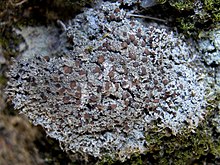| Bilimbia | |
|---|---|

| |
| Bilimbia sabuletorum in Portugal | |
| Scientific classification | |
| Domain: | Eukaryota |
| Kingdom: | Fungi |
| Division: | Ascomycota |
| Class: | Lecanoromycetes |
| Order: | Lecanorales |
| Family: | Ramalinaceae |
| Genus: | Bilimbia De Not. (1846) |
| Type species | |
| Bilimbia hexamera De Not. (1846) | |
| Synonyms | |
Bilimbia is a genus of lichen-forming fungi in the family Ramalinaceae.
Taxonomy
Before Bilimbia was circumscribed by Giuseppe De Notaris, the name had been used in botany. Reichenbach had attempted to use it for what is now known as the Bilimbi or Cucumber tree (Averrhoa bilimbi), but this usage was never validly published under botanical nomenclature rules.
The genus Bilimbia as defined by De Notaris in 1846 included two species, B. hexamera and B. tetramera. It became widely adopted among lichenologists, particularly in the British Isles where it was used consistently from William Mudd's 1861 flora through Duncan's 1959 guidebook. However, its use declined in the early 1900s when Alexander Zahlbruckner transferred the Bilimbia species into his broader concept of the genus Bacidia.
Several related genera were proposed during this period of taxonomic uncertainty. Philipp Maximilian Opiz created Weitenwebera in 1857 specifically to replace Bilimbia De Not., though this replacement name itself turned out to be a later homonym. Mycobilimbia Rehm was established in 1889 as a separate genus, notable for having no nomenclatural connections to De Notaris's original Bilimbia species. Another genus name, Probilimbia, was briefly mentioned by Edvard August Vainio in 1899 but is considered superfluous.
The taxonomy was later clarified when research showed that Reichenbach's use of Bilimbia did not constitute valid publication, meaning De Notaris's use remained valid. By 2001, four main European species were recognised: B. accedens, B. lobulata, B. microcarpa, and B. sabuletorum, with the type species B. hexamera now considered a synonym of B. sabuletorum. Molecular phylogenetic evidence suggests that the genus forms a well-supported monophyletic clade within the Ramalinaceae.
De Notaris did not specify a type species when he created the genus. Bruce Fink designated B. hexamera as the type in 1910. However, he used the now-obsolete American Code, and the new nomenclatural rules allow for his typification to be superseded by any later typification, unless the typification has been reaffirmed in the interim. In 1952, Rolf Santesson set B. hexamera as the type. In 1984, Josef Hafellner redesignated B. tetramera as the type, a decision that was followed by Timdal in 1991. However, B. tetramera is now known as Mycobilimbia tetramera. If B. tetramera is assigned as the type of Bilimbia, then Bilimbia becomes a synonym of, and the correct name for Mycobilimbia, which is taxonomically unfeasible. For this reason, a proposal was published in 2020 to conserve the name Bilimbia with B. hexamera as a conserved type. The proposal was accepted by the Nomenclature Committee for Fungi in 2023.
Species
- Bilimbia caloosensis (Tuck.) Fink (1935)
- Bilimbia caudata (Nyl.) Fink (1935)
- Bilimbia corcovadensis (Malme) Llop (2006)
- Bilimbia declinis (Tuck.) Fink (1935)
- Bilimbia granosa (Tuck.) Fink (1935)
- Bilimbia jeanjeanii B.de Lesd. (1936)
- Bilimbia lobulata (Sommerf.) Hafellner & Coppins (2004)
- Bilimbia microcarpa (Th.Fr.) Th.Fr. (1863)
- Bilimbia pulchra (Oxner) Oxner (1968)
- Bilimbia ravenelii (Tuck.) Fink (1935)
- Bilimbia rubidofusca (Willey) Fink (1935)
- Bilimbia rubricosa (Müll.Arg.) Fink (1935)
- Bilimbia sabuletorum (Schreb.) Arnold (1869)
- Bilimbia sabulosa A.Massal. (1852)
- Bilimbia sibiriensis (Willey) Oxner (1968)
- Bilimbia suballinita (Nyl.) Oxner (1968)
- Bilimbia sublecanorina (Nyl.) Szatala (1956)
- Bilimbia tetramera De Not. (1846)
References
- "Synonymy: Bilimbia De Not., G. bot. ital. 2(1.1): 190 (1846)". Species Fungorum. Retrieved 21 March 2021.
- Wijayawardene, Nalin; Hyde, Kevin; Al-Ani, Laith Khalil Tawfeeq; Somayeh, Dolatabadi; Stadler, Marc; Haelewaters, Danny; et al. (2020). "Outline of Fungi and fungus-like taxa". Mycosphere. 11: 1060–1456. doi:10.5943/mycosphere/11/1/8. hdl:10481/61998.
- ^ Veldkamp, J.F. (2004). "Bilimbia (Lichenes) resurrected". The Lichenologist. 36 (3–4): 191–195. doi:10.1017/S0024282904013908.
- De Notaris, G. (1846). "Frammenti lichenografici di un lavoro inedito". Giornale Botanico Italiano Ann. 2 (in Italian). 1 (1): 174–224, 299–330.
- Miadlikowska, Jolanta; Kauff, Frank; Högnabba, Filip; Oliver, Jeffrey C.; Molnár, Katalin; Fraker, Emily; et al. (2014). "A multigene phylogenetic synthesis for the class Lecanoromycetes (Ascomycota): 1307 fungi representing 1139 infrageneric taxa, 317 genera and 66 families". Molecular Phylogenetics and Evolution. 79: 132–168. doi:10.1016/j.ympev.2014.04.003. PMC 4185256. PMID 24747130.
- Timdal, Einar (1991). A Monograph of the Genus Toninia (Lecideaceae, Ascomycetes). Opera botanica. Vol. 110. Council for Nordic Publications in Botany. p. 24. ISBN 978-8788702613.
- Arcadia, Linda (2020). "(2722) Proposal to conserve the name Bilimbia (Ramalinaceae, lichenised Ascomycota) with a conserved type". Taxon. 68 (6): 1364–1365. doi:10.1002/tax.12166.
- May, Tom W.; Lendemer, James C. (2023). "Report of the Nomenclature Committee for Fungi: 22". Taxon. 72 (6): 1356–1363. doi:10.1002/tax.13099.
- Llop, Esteve (2006). "Bilimbia corcovadensis, a neotropical corticolous species of Bilimbia". The Lichenologist. 38 (3): 279–281. doi:10.1017/S0024282906005664.
| Taxon identifiers | |
|---|---|
| Bilimbia | |